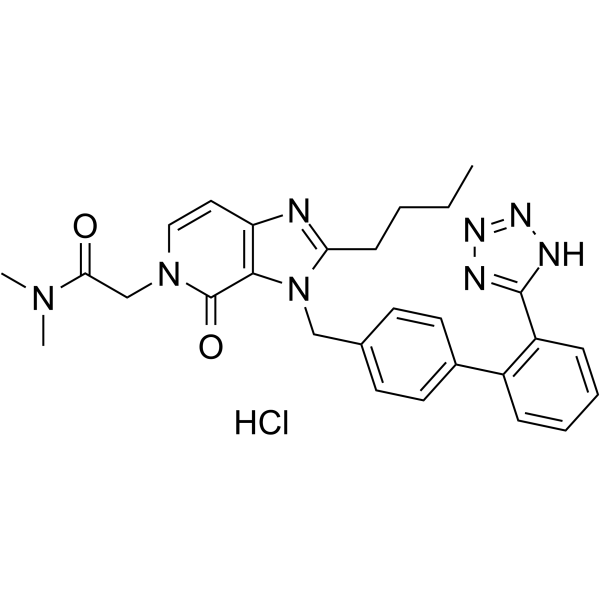1216884-39-7
| Name | EMD 66684 |
|---|---|
| Synonyms |
2-(2-Butyl-4-oxo-3-{[2'-(1H-tetrazol-5-yl)biphenyl-4-yl]methyl}-3,4-dihydro-5H-imidazo[4,5-c]pyridin-5-yl)-N,N-dimethylacetamide hydrochloride (1:1)
5H-Imidazo[4,5-c]pyridine-5-acetamide, 2-butyl-3,4-dihydro-N,N-dimethyl-4-oxo-3-[[2'-(1H-tetrazol-5-yl)[1,1'-biphenyl]-4-yl]methyl]-, hydrochloride (1:1) 2-(2-Butyl-4-oxo-3-{[2'-(1H-tetrazol-5-yl)-4-biphenylyl]methyl}-3,4-dihydro-5H-imidazo[4,5-c]pyridin-5-yl)-N,N-dimethylacetamide hydrochloride (1:1) |
| Description | EMD 66684 is an antagonist of Angiotensin II Type 1 (AT1) receptor. EMD 66684 shows potent binding affinities for the AT1 subtype Ang II receptor with an IC50 value of 0.7 nM. EMD 66684 also serves as an antiischemic cytoprotectant [1]-[5]. |
|---|---|
| Related Catalog | |
| Target |
Ang II receptor:0.7 nM (IC50) |
| In Vitro | Ang II is known to activate at least two receptor subtypes, namely, AT1 and AT2 receptors[1]. EMD 66684 (0.1 μM) decreases Ang II (0.1 mM)-induced in basal and NS-induced NPY overflow, attenuates the NS-induced stimulation of both NE and NPY release[1]. EMD 66684 (0.01 nM-1 μM; 0, 30, 60 min) exhibits a time-dependent inhibition against Ang II in DMR (dynamic mass redistribution) responses, with IC50s of 181.97 nM (0 min), 0.22 nM (30 min), 0.17 nM (60 min), respectively[2]. EMD 66684 exhibits binding affinities for the AT1 subtype Ang II receptor with an IC50 value of 0.7 nM in rat adrenal cortical membranes, and inhibits Ang II-Induced contraction in rabbit aortic rings with an IC50 value of 0.2 nM[3]. Cell Viability Assay[1] Cell Line: Hep G2 cells (liver hepatocellular carcinoma cell line) Concentration: 1 nM Incubation Time: 1 hour Result: Completely blocked the Ang II responses Ang II-induced response. |
| In Vivo | EMD 66684 (0.1, 0.3, 1 mg/kg; i.v.; once) results in a long lasting fall in blood pressure[3]. EMD 66684 (0.1 μM; 45 min) decreases the NS-induced overflow of NE and NPY from preparations from SHRs at 10-12 weeks old[4]. Animal Model: Conscious furosemide-treated SHR (Spontaneous Hypertension Rat)[3] Dosage: 0.1, 0.3, 1 mg/kg Administration: Intravenous injection; once; as potassium salts to conscious furosemide-treated SHR Result: Showed a long lasting fall in blood pressure, resulted mean arterial pressure (MAP) decreased in a dose-dependent manner. |
| References |
[5]. Avkran M, et al. Treatment of ischemia with an angiotensin II antagonist: UK, GB2337701. 1999-12-01. |
| Molecular Formula | C28H31ClN8O2 |
|---|---|
| Molecular Weight | 547.051 |
| Exact Mass | 546.225830 |
